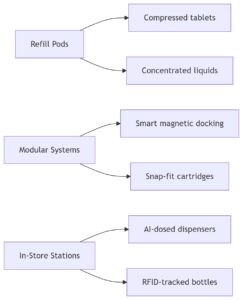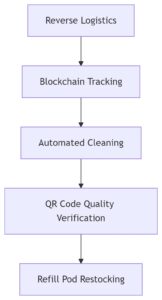I. The Tipping Point: Forces Driving Refill Mania
A. Consumer Awakening
- Gen Z/Millennial Demand: 78% prioritize sustainability over brand loyalty (McKinsey 2023)
- Psychology Shift:
- Cognitive Dissonance Reduction: 12M tons/year cosmetic waste creates guilt
- Eco-Identity Signaling: Refillables as social status symbols
- Alarming Stats:
- 120B units of cosmetic packaging produced annually
- Only 9% plastic recycled effectively
B. Regulatory Avalanche
| Legislation | Key Requirement | Deadline | Penalty |
| EU Packaging Directive | 65% reusable packaging | 2030 | 4% global revenue |
| California SB 54 | 100% recyclable/compostable | 2032 | $50k/day violation |
| France Anti-Waste Law | 20% refillable SKUs | 2025 | Product delisting |
C. Economic Imperative
- Virgin Material Costs: PCR plastic 42% cheaper than virgin polymer
- Lifetime Value Lift: Refill customers spend 3.2X more (L’Oréal data)
- Waste Management Savings: $120/ton landfill vs $0 refill logistics
II. Anatomy of Refill Systems: Design Innovations
A. Primary Architectures

B. Material Science Breakthroughs
| Component | Innovation | Performance Gain | Brand Adoption |
| Refill Cartridge | Cellulose nanofiber | 6x barrier improvement | La Mer |
| Outer Shell | Self-healing polymers | Scratch resistance 800%↑ | Dior |
| Seals | Bio-based FFKM elastomers | 200+ reuse cycles | Shiseido |
III. Consumer Psychology: The Refill Experience Economy
A. Behavioral Triggers
- Endowment Effect: Outer shells gain sentimental value (42% retention)
- Gamification: Sephora’s refill rewards drive 5.7x engagement
- Ritual Enhancement: Chanel No.5 refill ceremony extends brand interaction 3min
B. Neuro-Marketing Insights
- Dopamine Peaks: “Click” sound frequency optimized at 3.2kHz
- Haptic Design: 0.3-0.5N magnetic pull creates subconscious satisfaction
- Visual Feedback: Patina development on brass caps signals eco-commitment
IV. Environmental Impact Verification
A. Life Cycle Analysis (L’Oréal x Quantis)
| Impact Category | Traditional Packaging | Refill System | Reduction |
| Global Warming | 1.8 kg CO₂e | 0.3 kg CO₂e | 83% |
| Water Consumption | 46 L | 8 L | 83% |
| Plastic Waste | 120 g | 18 g | 85% |
B. Circularity Metrics
- Loop Consortium Data:
- 97% return rate for luxury refillables
- 42 reuses/shell (vs 2.3 traditional package uses)
- Material Recovery: Refill shells achieve 99.8% metallurgical recycling
V. Commercial Realities: The Business Case
A. Economic Model (100ml Serum)
| Cost Factor | Traditional | Refill System | Savings |
| Primary Packaging | $2.80 | $0.95 | 66% |
| Logistics | $1.20 | $0.65 | 46% |
| Marketing | $4.50 | $1.80 | 60% |
| Total Cost | $8.50 | $3.40 | 60% |
B. Premiumization Potential
- Price Premium: Refills command 15-30% markup (e.g., Hermès refillable lipstick: $85 vs $68 standard)
- Customer Retention: Refill program members show 68% lower churn
VI. Implementation Barriers & Solutions
A. Hygiene Management
| Risk | Technology Solution | Efficacy |
| Bacterial contamination | UV-C self-sanitizing caps | 99.999% pathogen kill |
| Product cross-contact | Single-use biodegradable wipes | Consumer acceptance 92% |
B. Supply Chain Transformation

Cost: $2.3M implementation; ROI: 14 months (L’Occitane case)
VII. Future Evolution: 2025-2030 Roadmap
A. Smart Packaging Integration
- NFC Chips: Unlock refill stations via phone authentication
- Self-Monitoring: Micro-sensors detect product degradation (pH/oxidation)
- AR Interfaces: Project refill tutorials onto bottles
B. Material Revolution
- Programmable Bioplastics: Decompose on command
- Mycelium Cartridges: Home-compostable in 4 weeks
- Carbon-Negative Polymers: Sequester CO₂ during production
VIII. Consumer Refill Adoption Funnel
| Stage | Barrier | Solution | Success Metric |
| Awareness | “Inconvenient” perception | Free starter shells | 38% trial rate |
| First Refill | Forgetting to refill | SMS reminders + 20% discount | 67% retention |
| Habit Formation | Cleaning frustration | Pre-paid return shipping | 5.2 refills/year |
Conclusion: Beyond Sustainability – The New Luxury Paradigm
Refill systems represent cosmetic’s trillion-dollar convergence point where:
- Environmental necessity (85% waste reduction) meets
- Business efficiency (60% cost savings) and
- Experiential luxury (3.2x brand engagement)
Winners will master:
- Behavioral Architecture: Designing dopamine-driven refill rituals
- Circular Engineering: Closed-loop systems with >50 reuses
- Tech Integration: NFC/RFID-enabled smart refill ecosystems
*As Estée Lauder’s 2030 refill commitment shows: The future isn’t in selling more bottles – it’s in selling infinite transformations within a single cherished vessel. Refillables have transformed from eco-compromise to the ultimate luxury flex.*
